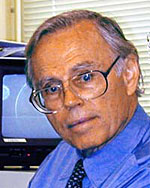Prize Recipient

Ernst G. Bauer
Arizona State Unversity
Citation:"For contributions to the science of thin-film nucleation and growth, and for the invention of Low Energy Electron Microscope."
Background:Ernst G. Bauer received his MS (1953) and PhD (1955), both in physics, from Munich University, Germany. In 1958 he moved to the Michelson Laboratory in China Lake, California, where he became Head of the Crystal Physics Branch and U.S. citizen. In 1969 he accepted the position of Professor and Director of the Physics Institute at the Technical University Clausthal in Germany. In 1991 he was appointed Distinguished Research Professor at the Arizona State University.
His classic early work (1958) on the classification of thin film growth modes, which is used worldwide today, provided the theoretical thermodynamic understanding of epitaxy. In 1962 he invented LEEM (Low Energy Electron Microscopy). In the late eighties/early nineties he extended the LEEM technique in two directions by developing two new surface microscopy methods: Spin-Polarized Low Energy Electron Microscopy (SPLEEM) and Spectroscopic Photo Emission and Low Energy Electron Microscopy (SPELEEM). Using these methods a comprehensive (structural, chemical, magnetic, electronic) characterization of surfaces and thin films on the 10 nm scale is now available.
Selection Committee:
Randall Feenstra (Chair)(DCMP), Don Hamnn (12/04)(DCMP), Ruud Tromp ('03 winner), Wilson Ho (V. Chair)(12/05)(DCMP), Leonard C. Feldman (12/05)(DCMP)
